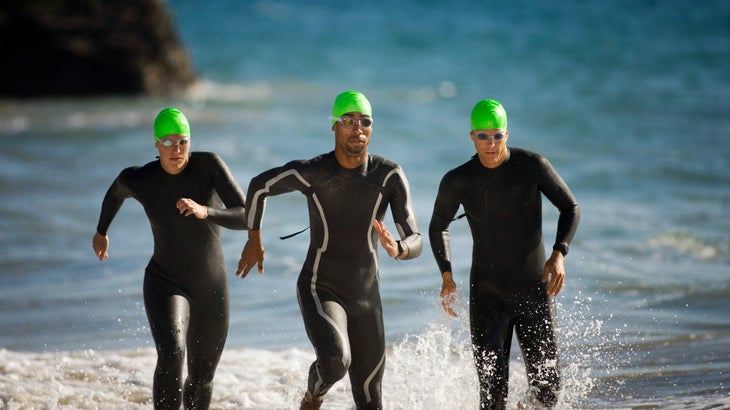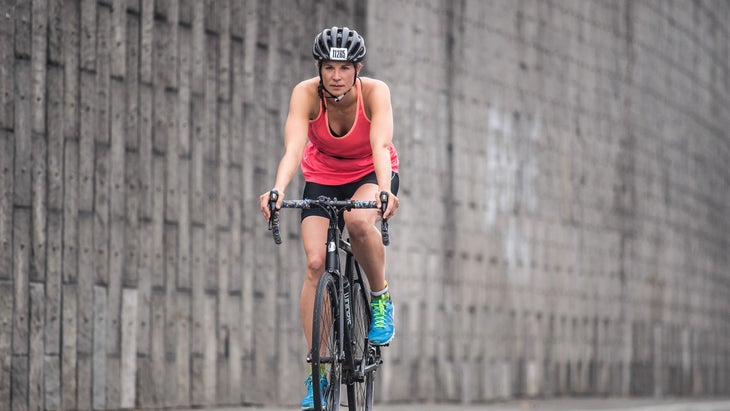New perk! Get after it with local recommendations just for you. Discover nearby events, routes out your door, and hidden gems when you sign up for the Local Running Drop.
One of the silver linings of COVID disrupting our regularly scheduled lives this past year has been a renaissance for outdoor activities—especially cycling. Maybe you were one of the people that bought a bike this last year when your gym closed and now you want to know: What next? As life returns to normal patterns, perhaps you’re looking for a new challenge or thinking about taking your newfound cycling to the next level. Going from cyclist to triathlete is a great next step and you’ll find a welcoming community to support you. Lucky for you you already have the longest part of the triathlon under control: the bike!
Hopefully, we can go over a few things here to help make your transition from cycling to triathlon as smooth and fulfilling as possible.
Triathlon Distances
Triathlon events range in distance from so-called “super sprint” ( typically a 0.5K swim, 10K ride, and 1.5K run), up to a “sprint” (0.75K, 20K, 5K), Olympic or “international distance” (1500m, 40K, 10K), to half-iron or 70.3 (1.2mi., 56mi., 13.1mi.), iron-distance (2.4mi., 112mi., 26.2mi.), and even beyond. While biking is the biggest portion of the event, how long it takes care vary depending on course, terrain, and your ability.
| Triathlon Distance | Swim Distance | Bike Distance | Run Distance | Average Participant Finish Time |
|---|---|---|---|---|
| Super sprint | .5K | 10K | 1.5K | :45-1:00 |
| Sprint | .75K | 20K | 5K | 1:15-1:45 |
| Olympic | 1.5K | 40K | 10K | 2:30-3:30 |
| Half-Iron | 1.2mi. | 56mi. | 13.1mi. | 5:00-6:30 |
| Iron | 2.4mi. | 112mi. | 26.2mi. | 10:00-14:00 |
RELATED: What You Need to Know About Every Triathlon Distance
Triathlon Gear
The good news if you are coming from cycling is you already have the most expensive part of triathlon out of the way: the bike. As tempting as it is and despite whatever marketing you may hear, if you are new to triathlon do not let anyone sell you another bike! The bike you have is just fine. Add in a set of basic running shoes, goggles, and a swimsuit and you are good to go. Keep things simple. Early on there are so many other things that can hold you back far more than the lack of a fancy triathlon bike, carbon super shoes, or goggles that display your pace. Let us cover some of those fundamentals next.
RELATED: 15 Must-Haves: Essential Beginner Tri Gear

Getting Started Swimming
Of the three sports, swimming will often be the biggest hurdle for the cyclist-turned-triathlete. The cold water, lack of being able to see your surroundings, and not being able to breath whenever you want can be unsettling only because they are unfamiliar. If you don’t have a swim background building that familiarity by getting to the pool and into the open water is often the key to an enjoyable swim on race day. Don’t get overly focused on the perfect stroke, or all the YouTube drills promising to make you fast. Doing drills with a quiet lane all to yourself is not the reality of a triathlon swim. While that technique work has value, it’s likely best for later as you gain more experience. Basic confidence in the water with other people around you is step one. Joining your local masters swim group can be the best way to get there. They meet often, you’ll have safety in numbers, get some light instruction, and you will get used to swimming with choppy water and some contact with other swimmers just like on race day.
More swim tips:
- A Beginner’s Guide for Learning How to Swim for Triathlon
- Mastering Triathlon Swim Training
- New to Open Water Swimming? Here’s Your Crash Course
Getting Started Running
Swimming can be intimidating, but like cycling it is very joint friendly and adding it in usually carries low injury risk and is a net positive for overall fitness. However, many people coming from cycling get derailed by run injuries before they even get to their first triathlon. Ironically, the cardiovascular fitness gained through cycling can blind the cyclist to injury risk because breathing will come easy at first and running won’t “hurt” the way it might for the normal beginner runner. Because of this you might be tempted to run faster and go longer to get the same feeling of exertion you get on the bike. However, the muscles and tendons are a weak link when you first start running, lagging far behind the heart and lungs initially. The bike holds all your body weight when cycling, while in running the legs must have the ability to withstand 2-3 times your body weight with each step. Building resilience to this repetitive load takes time and lots of patience.
How To Avoid Run Injuries:
- I am a huge proponent of using run/walks and hiking to build up time on your feet and strengthen connective tissue when coming to triathlon from cycling—especially for your long runs. Even brief 30-second to 1-minute walk breaks can offload repetitive tissue stress and help avoid overuse injuries. Any beginning run training should incorporate repeating patterns like: 2-minute run, 1-minute walk, 2-minute run at first. Then, slowly increase the total run time over the weeks. Walk with purpose though, it is still training. You can keep your heart rate quite high with a good walk pace between runs.
- I am also a fan of increasing frequency of runs as opposed to length of runs in order to spread the run load out more in the week. There is nothing wrong with breaking your longer weekly run into two parts for example. You dramatically reduce the injury risk and you will also have higher quality running in both sessions. Doing things like a short brick run off the bike and then an afternoon run later in the day, after a meal and some rest, is a great way to get plenty of running done for your event. This is a strategy even the best athletes in the world use to build fitness and stay healthy.
- Keep your bike volume up when you first transition from cycling to triathlon. Many cyclists have built up good overall fitness on the bike and then let that drop too quickly before they can safely replace it with equal run training. Leverage your comfort with cycling to get a lot of the training you need for your triathlon done on the bike and keep your strength a strength while your body adapts to the new running load.

Common Issues Coming From Cyclist to Triathlete
Triathlon Nutrition
After run injuries and swim anxiety, GI distress is probably the number one challenge for the cyclist-turned-triathlete—especially on race day when all three sports are done consecutively. With the rider’s weight supported by the bike, cycling is a relatively smooth and efficient sport, with lots of blood volume available to both support the demands of the working muscles and digestion without much jostling and bouncing of the gut. That means cyclists can often eat just about anything they want while riding. However, once you add in the bouncing and more limited blood flow of running, many cyclists find they must be much more careful about their fueling.
There are countless successful fueling strategies employed by triathletes. Many can be found here. The main thing to understand coming from cycling you will likely need to change what worked before, experiment with different strategies, and practice it many, many times in training before race day.
How to Adapt for Triathlon Nutrition:
Doing regular event simulations with similar demands in terms of temperature and bike duration are invaluable to figure out how your gut is doing on the run and what adjustments you need to make to your nutrition plan before race day. For example, if you plan to put all your calories in your water bottle for a warm event, you will quickly learn from an unsettled stomach in your simulations that you also need a plan for getting more plain water in your system to meet hydration needs.
Pacing
The third common place cyclists make mistakes in triathlon is in their pacing of the bike. Many overly focus on the bike segment of the event, trying to set the fastest bike split for example. A quite common mindset for the cyclist turned triathlete is to survive the swim, blaze the bike because it is familiar, and then be forced to hang on for the run. This causes them to suffer badly on the run from dead legs, side stitches, or GI distress from over-biking. I highly encourage the cyclist turned new triathlete to embrace the sport as a whole and think in terms of time over the whole course not just the bike. Use your bike strength to set up a successful and enjoyable run through realistic pacing and tested fueling.
How to Pace for Triathlon:
Simply put if you can not eat and drink during your ride because you are breathing too heavy, you are going too hard to run well later. Back it off a notch, get your nutrition right, and set the stage for a good run.
RELATED: Everything You Need to Know Before Your First Triathlon
Ready to take your biking to the next challenge and try a triathlon? Check out our collection of training plans for triathletes. A few of our favorites: